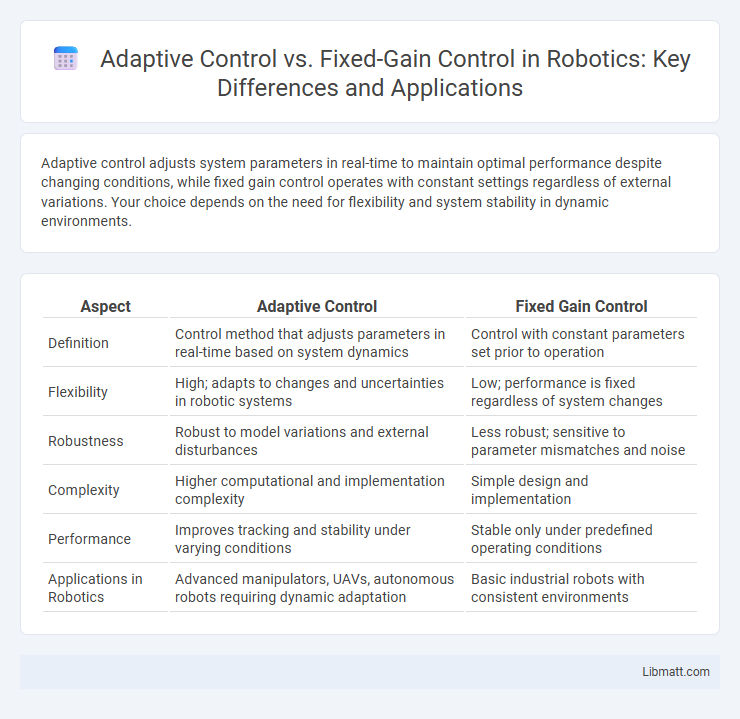Adaptive control adjusts system parameters in real-time to maintain optimal performance despite changing conditions, while fixed gain control operates with constant settings regardless of external variations. Your choice depends on the need for flexibility and system stability in dynamic environments.
Table of Comparison
| Aspect | Adaptive Control | Fixed Gain Control |
|---|---|---|
| Definition | Control method that adjusts parameters in real-time based on system dynamics | Control with constant parameters set prior to operation |
| Flexibility | High; adapts to changes and uncertainties in robotic systems | Low; performance is fixed regardless of system changes |
| Robustness | Robust to model variations and external disturbances | Less robust; sensitive to parameter mismatches and noise |
| Complexity | Higher computational and implementation complexity | Simple design and implementation |
| Performance | Improves tracking and stability under varying conditions | Stable only under predefined operating conditions |
| Applications in Robotics | Advanced manipulators, UAVs, autonomous robots requiring dynamic adaptation | Basic industrial robots with consistent environments |
Introduction to Control Systems
Adaptive control dynamically adjusts controller parameters in real-time to cope with system uncertainties and changing environments, enhancing system performance and robustness. Fixed gain control employs constant controller parameters designed for specific operating conditions, offering simplicity but limited flexibility under varying system dynamics. Control systems leveraging adaptive control achieve improved stability and accuracy in nonlinear or time-varying processes compared to traditional fixed gain controllers.
Overview of Adaptive Control
Adaptive control dynamically adjusts system parameters in real time to maintain optimal performance despite changes in the environment or system dynamics, unlike fixed gain control that uses constant parameters. This approach employs algorithms such as model reference adaptive systems (MRAS) or self-tuning regulators to continuously update controller gains based on feedback and error signals. Your system benefits from adaptive control by improving robustness, reducing steady-state error, and enhancing responsiveness to uncertainties and disturbances.
Overview of Fixed Gain Control
Fixed gain control employs a constant control parameter that remains unchanged regardless of system variations or external disturbances. This method simplifies controller design and implementation but may lead to suboptimal performance in dynamic or uncertain environments. Its stability relies on precise tuning, as fixed gain controllers can struggle to maintain accuracy when faced with nonlinearities or time-varying processes.
Key Differences Between Adaptive and Fixed Gain Control
Adaptive control continuously adjusts its parameters based on system performance and environmental changes, providing robustness in uncertain or time-varying conditions. Fixed gain control relies on predetermined, constant parameters that optimize performance for a specific operating condition but may degrade under varying circumstances. The key difference lies in adaptivity, where adaptive control enhances stability and accuracy across diverse scenarios, while fixed gain control offers simplicity and predictability in stable environments.
Advantages of Adaptive Control
Adaptive control offers significant advantages over fixed gain control by continuously adjusting its parameters to compensate for system uncertainties and varying operating conditions, ensuring more precise and stable performance. It enhances system robustness by automatically tuning control signals in real-time, reducing overshoot, settling time, and steady-state error compared to fixed gain methods. This dynamic adaptability makes it ideal for complex, nonlinear, or time-varying systems where fixed gain control fails to maintain optimal performance.
Limitations of Fixed Gain Control
Fixed Gain Control faces limitations in handling system dynamics that vary over time or under different operating conditions, often leading to suboptimal performance or instability. It cannot adjust to external disturbances or changes in system parameters, reducing efficiency and robustness. Your system benefits from Adaptive Control as it continuously tunes control parameters for improved accuracy and resilience.
Application Scenarios for Adaptive Control
Adaptive control excels in dynamic environments where system parameters vary, such as aerospace flight systems and robotics with changing payloads. It is ideal for processes with nonlinearities or uncertainties, including chemical reactors and autonomous vehicles, ensuring consistent performance despite disturbances. Industries requiring real-time optimization and precision, like manufacturing automation and renewable energy systems, benefit significantly from adaptive control's ability to tune controller parameters continuously.
Application Scenarios for Fixed Gain Control
Fixed gain control is widely applied in systems where operating conditions are stable and predictable, such as simple industrial automation and basic temperature regulation. Its straightforward design and low computational requirements make it ideal for cost-sensitive applications requiring consistent performance without the need for real-time parameter adjustments. You benefit from enhanced reliability and ease of maintenance when utilizing fixed gain control in environments with minimal disturbances and well-defined dynamics.
Performance Comparison: Adaptive vs Fixed Gain
Adaptive control systems continuously adjust parameters in real-time to optimize performance under varying conditions, resulting in enhanced stability and responsiveness compared to fixed gain control, which uses constant parameters. Fixed gain control may perform adequately under steady or predictable environments but often struggles with dynamic changes, leading to suboptimal response or instability. Your system benefits from adaptive control by maintaining optimal performance and robustness across a wider range of operating conditions.
Conclusion and Future Trends in Control Systems
Adaptive control offers superior performance over fixed gain control by continuously adjusting parameters to dynamic environments, enhancing system stability and robustness. Future trends in control systems emphasize integration with artificial intelligence and machine learning, enabling predictive adaptation and autonomous optimization. Your choice of control strategy should consider the increasing demand for flexibility and intelligence in complex, real-time applications.
Adaptive control vs Fixed gain control Infographic

 libmatt.com
libmatt.com